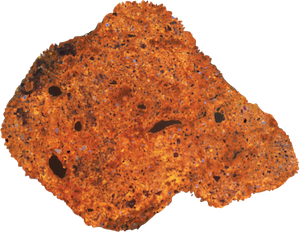Understanding the geochemical signals of pedogenic carbonates
Pedogenic carbonate (secondary carbonate formed during pedogenesis) is an important terrestrial archive in paleoclimate studies. For instance, its carbon isotopic composition (\(\delta^{13}C\)) recorded atmospheric CO2 levels, vegetation \(\delta^{13}C\), and soil productivity. Whereas its oxygen isotopic composition (\(\delta^{18}O\)) recorded rainfall \(\delta^{18}O\) and evaporation, which in turn reflect air circulation and humidity, respectively.

- Cathodoluminescence image of a Pliocene calcite nodule from Teruel Basin, Spain. The bright orange luminescence suggests the existence of Mn2+, indicating that the nodule was formed under water-saturated, reducing environment (photo credit: Nicole Czwakiel).
However, like other proxies (sensors that respond to environmental parameters), both \(\delta^{13}C\) and \(\delta^{18}O\) are affected by multiple environmental forcings, making it difficult to quantitatively extract paleoenvironmental information. Additionally, the formation of soil carbonates is highly seasonal in response to changes in temperature, rainfall, and soil respiration, suggesting that they record seasonal climate signals rather than annual means. Therefore, it is essential to understand their formation time and the environmental signals they recorded before applying them for paleoenvironmental reconstructions.
In our study area, the Chinese Loess Plateau, we applied systematic spatiotemporal \(\delta^{13}C\) and \(\delta^{18}O\) analyses, proxy system modeling, and numerical modeling to understand the formation time of soil carbonates in this particular region, as well as the processes governing their isotopic values.
Related Publications:
- Da J, Zhang Y G, Li G, et al. Aridity-driven decoupling of δ13C between pedogenic carbonate and soil organic matter[J]. Geology, 2020, 48(10): 981-985.
- Da J, Li G K, Ji J. Seasonal changes in the formation time of pedogenic carbonates on the Chinese Loess Plateau during Quaternary glacial cycles[J]. Quaternary Science Reviews, 2023, 305: 108008.
